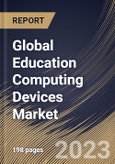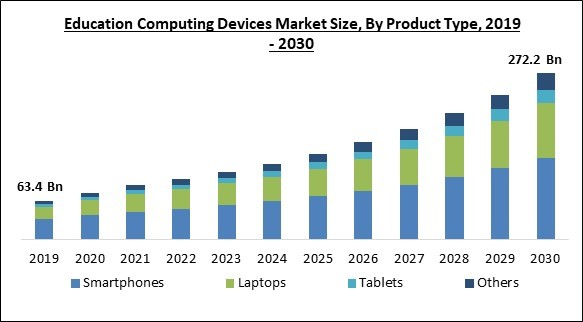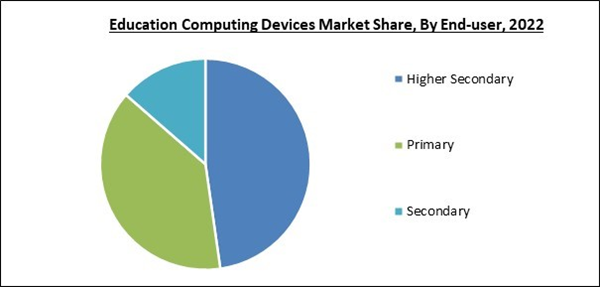The Global Education Computing Devices Market size is expected to reach $272.2 billion by 2030, rising at a market growth of 13.7% CAGR during the forecast period.
Tablets are a technological solution that offers a variety of hardware and applications to support digital learning in the classroom. Therefore, the Tablets segment acquired $7,139.3 million revenue in the market in 2022. Teachers may access educational content, design digital assignments, and provide students with immediate feedback using tablets. The content can be personalized for each pupil and facilitate an interactive learning experience. Tablets can be used to promote distance learning and aid in bridging the digital divide by providing students with access to the same educational resources regardless of their location. Some of the factors impacting the market are increase in global digitization, rapid development of online education platforms, and digital divide and unequal Internet access.
In educational institutions, digitization has led to significant demand for PCs, laptops, and notebooks. The importance of online learning in educational institutions has boosted the need for bring-your-own-device (BYOD) policies. A further factor driving the expansion of the market for educationcomputing devices is the development of smart teaching techniques. Moreover, the rapid pace of digitalization in regions like Middle East, Africa, and Latin America is also presenting significant possibilities to industry participants. Therefore, need for education computing devices will grow as a result of the rising global digitization. The fast development of software solutions is providing educational institutions with improved resource planning tools, enabling faculty members to create more complex course content and efficiently manage classrooms and schools. Online learning platforms are supported by the idea that students are increasingly becoming interested in learning from the comfort of their homes. To improve the learning experience, online education combines a variety of multimedia components, including videos, presentations, and interactive activities. The adaptability of online learning is a critical factor in its expansion. As a result of the rising development of online education platform, the market is estimated to grow.
However, while developed countries are generally known for their technical agility, emerging economies are expected to make small strides toward digitization. LMIC, or low- and middle-income nations, are notoriously sluggish to adopt digital technology. The global prevalence of the digital divide is held responsible for this. Lack of access to essential technology and Internet connectivity may affect students from underprivileged families or marginalized areas, escalating already-existing educational inequalities. The difficulty of providing all students with fair access to computing devices for educational purposes needs to be resolved. Hence, all these factors pose a challenge for the market.
The market research report covers the analysis of key stake holders of the market. Key companies profiled in the report include Xiaomi Corporation, Dell Technologies, Inc., Lenovo Group Limited, Samsung Electronics Co., Ltd., Acer, Inc., ASUSTeK Computer Inc., Apple, Inc., OPPO Company, and HP, Inc.
Tablets are a technological solution that offers a variety of hardware and applications to support digital learning in the classroom. Therefore, the Tablets segment acquired $7,139.3 million revenue in the market in 2022. Teachers may access educational content, design digital assignments, and provide students with immediate feedback using tablets. The content can be personalized for each pupil and facilitate an interactive learning experience. Tablets can be used to promote distance learning and aid in bridging the digital divide by providing students with access to the same educational resources regardless of their location. Some of the factors impacting the market are increase in global digitization, rapid development of online education platforms, and digital divide and unequal Internet access.
In educational institutions, digitization has led to significant demand for PCs, laptops, and notebooks. The importance of online learning in educational institutions has boosted the need for bring-your-own-device (BYOD) policies. A further factor driving the expansion of the market for educationcomputing devices is the development of smart teaching techniques. Moreover, the rapid pace of digitalization in regions like Middle East, Africa, and Latin America is also presenting significant possibilities to industry participants. Therefore, need for education computing devices will grow as a result of the rising global digitization. The fast development of software solutions is providing educational institutions with improved resource planning tools, enabling faculty members to create more complex course content and efficiently manage classrooms and schools. Online learning platforms are supported by the idea that students are increasingly becoming interested in learning from the comfort of their homes. To improve the learning experience, online education combines a variety of multimedia components, including videos, presentations, and interactive activities. The adaptability of online learning is a critical factor in its expansion. As a result of the rising development of online education platform, the market is estimated to grow.
However, while developed countries are generally known for their technical agility, emerging economies are expected to make small strides toward digitization. LMIC, or low- and middle-income nations, are notoriously sluggish to adopt digital technology. The global prevalence of the digital divide is held responsible for this. Lack of access to essential technology and Internet connectivity may affect students from underprivileged families or marginalized areas, escalating already-existing educational inequalities. The difficulty of providing all students with fair access to computing devices for educational purposes needs to be resolved. Hence, all these factors pose a challenge for the market.
Product Type Outlook
By product type, the market is categorized into smartphones, laptops, tablets, and others. The laptops segment covered a considerable revenue share in the market in 2022. The growth of the segment is owed to initiatives like Laptops in Education PC, which is a program that provides students with laptops to improve their academic performance. Such initiatives aim to close the digital divide between people with access to technology and those without access. Such programs also ensure that all pupils, regardless of their socioeconomic status, have access to the same educational resources.End-user Outlook
Based on end-user, the market is divided into primary, secondary and higher secondary. The higher secondary segment witnessed the largest revenue share in the market in 2022. The reasons expected to drive the segment's expansion include the higher secondary students' increasing use of education computing devices as they frequently engage in college and career preparation activities, such as creating college applications, researching universities, and exploring career paths. Students can use computing devices to access college information portals, explore for scholarships, participate in online college fairs, and utilize career exploration tools, enabling them to make informed decisions about their future education and careers.Regional Outlook
Region wise, the market analyzed across North America, Europe, Asia Pacific and LAMEA region. In 2022, the North America region led the market by generating the highest revenue share. One of the factors fueling the expansion of the regional market is the region's improved economic status and government attempts to upgrade the infrastructure in both the commercial and educational sectors. The use of laptop computers and wireless devices in educational institutions has grown during the past few years.The market research report covers the analysis of key stake holders of the market. Key companies profiled in the report include Xiaomi Corporation, Dell Technologies, Inc., Lenovo Group Limited, Samsung Electronics Co., Ltd., Acer, Inc., ASUSTeK Computer Inc., Apple, Inc., OPPO Company, and HP, Inc.
Strategies Deployed in the Market
- Mar-2023: Xiaomi Corporation teamed up with United Way India, an India-based NPO, to deliver digital solutions to schools across Karnataka. The partnership would facilitate the transformation of the education infrastructure in Karnataka.
- Mar-2023: Samsung Electronics Co Ltd unveiled WAC interactive display. The display comes in 65, 75, and 86-inch models and has a 3-in-1 USB-C port connectivity. Additionally, the display comes with 20 multi-touch dual-sided pens.
- Jan-2023: Samsung Electronics today unveiled a new interactive display with upgraded features and a powerful software solution at Bett (British Educational Training and Technology) 2023, the world’s largest education technology exhibition, in London. The more than
- Jan-2022: Dell Technologies Incorporated signed a partnership with Intel, a semiconductor manufacturing company, to deliver educational technology-as-a-service (ETaaS) solutions. The partnership would facilitate the schools to overcome the technological barriers.
- Jan-2022: Lenovo released Lenovo 10w Tablet for education purposes. The laptop features a 10.1-inch Gorilla Glass-protected display and a 16:10 aspect ratio. Furthermore, the laptop has a Snapdragon 7c compute platform and extended battery life.
- Dec-2020: Xiaomi Corporation introduced Xiaomi Mi Notebook 14 e-Learning Edition, a laptop made specifically for educational purposes. The laptop features 8GB RAM and an Intel Core i3 processor. The laptop has a thickness of 17.9mm and weighs 1.5kg.
Scope of the Study
By Product Type
- Smartphones
- Laptops
- Tablets
- Others
By End-user
- Higher Secondary
- Primary
- Secondary
By Geography
- North America
- US
- Canada
- Mexico
- Rest of North America
- Europe
- Germany
- UK
- France
- Russia
- Spain
- Italy
- Rest of Europe
- Asia Pacific
- China
- Japan
- India
- South Korea
- Singapore
- Malaysia
- Rest of Asia Pacific
- LAMEA
- Brazil
- Argentina
- UAE
- Saudi Arabia
- South Africa
- Nigeria
- Rest of LAMEA
Key Market Players
List of Companies Profiled in the Report:
- Xiaomi Corporation
- Dell Technologies, Inc.
- Lenovo Group Limited
- Samsung Electronics Co., Ltd.
- Acer, Inc.
- ASUSTeK Computer Inc.
- Apple, Inc.
- OPPO Company
- HP, Inc.
Unique Offerings
- Exhaustive coverage
- The highest number of Market tables and figures
- Subscription-based model available
- Guaranteed best price
- Assured post sales research support with 10% customization free
Table of Contents
Chapter 1. Market Scope & Methodology
Chapter 2. Market At a Glance
Chapter 3. Market Overview
Chapter 5. Global Education Computing Devices Market by Product Type
Chapter 6. Global Education Computing Devices Market by End-user
Chapter 7. Global Education Computing Devices Market by Region
Chapter 8. Company Profiles
Companies Mentioned
- Xiaomi Corporation
- Dell Technologies, Inc.
- Lenovo Group Limited
- Samsung Electronics Co., Ltd.
- Acer, Inc.
- ASUSTeK Computer Inc.
- Apple, Inc.
- OPPO Company
- HP, Inc.
Methodology

LOADING...










